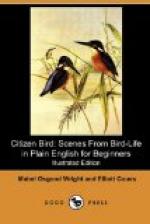Belongs both to the Ground Gleaners and the Wise Watchers.
THE CEDAR WAXWING
(THE POLITE BIRD)
“This is the bird, Nat, that you saw in the cedar tree, where you said it was ‘sitting about doing nothing,’” continued the Doctor.
“The reason of this seeming idleness is, that he belongs to the small group of birds who do not nest until June, and hereabouts rarely begin their homes before the middle of that month. Waxwings are very gentle, affectionate birds; before the nesting season, and after their families are able to take care of themselves, they wander about in flocks of sometimes thirty or forty, keeping close together, both when they fly and when they take their seats. They spend most of the time in the trees where they feed, whispering to one another in their quiet way, and you will very seldom see them on the ground.
“Your best chance to watch them is either before the leaves are out or after they have fallen, when a flock will sometimes sit for half an hour in a bare tree, exchanging civilities, stroking each other’s feathers, and passing food around. This trait has given them the reputation of being the most polite birds in all Birdland. One will find a dainty morsel and offer it to his next neighbor, who passes it on—hunt-the-slipper fashion—until some one makes up his mind to eat it, or returns it to its original owner. All the while such a pleasant lunch is going on, the amiable birds make complimentary remarks to one another about their dress—how very handsome is one’s long pointed topknot, what a becoming yellow border another’s tail has, and how particularly fine are the coral-red bangles on the wings of a third—which is much better than if they should pick each other to pieces and talk about ‘frumps’ under their breath.
“Some people have complained that the Cedar Waxwing eats cherries, and have given him the name of ‘Cherry Bird’; but the Wise Men say that he really eats very few cherries or other garden fruits, more than half of his food being wild berries, such as those of the evergreen juniper we commonly call ‘cedar.’
[Illustration: Cedar Waxwing]
“He may be called one of the best of neighbors; for, besides feeding his young on many different kinds of destructive insects, he eats cutworms and the wicked beetles which destroy so many grand old elm trees. And you know it is always nice to have polite neighbors.”
The Cedar Waxwing.
Length about seven inches.
Upper parts quiet Quaker brown, very smooth and satiny, with a fine long, pointed crest on the head.
Rich velvety black about the beak and in a line through the eye.
A yellow band across end of tail, and some little points like red sealing-wax on the inner wing-feathers, from which it takes the name “Waxwing.”
A Citizen of North America from the Fur Countries southward, visiting all but the most southern of the United States.




